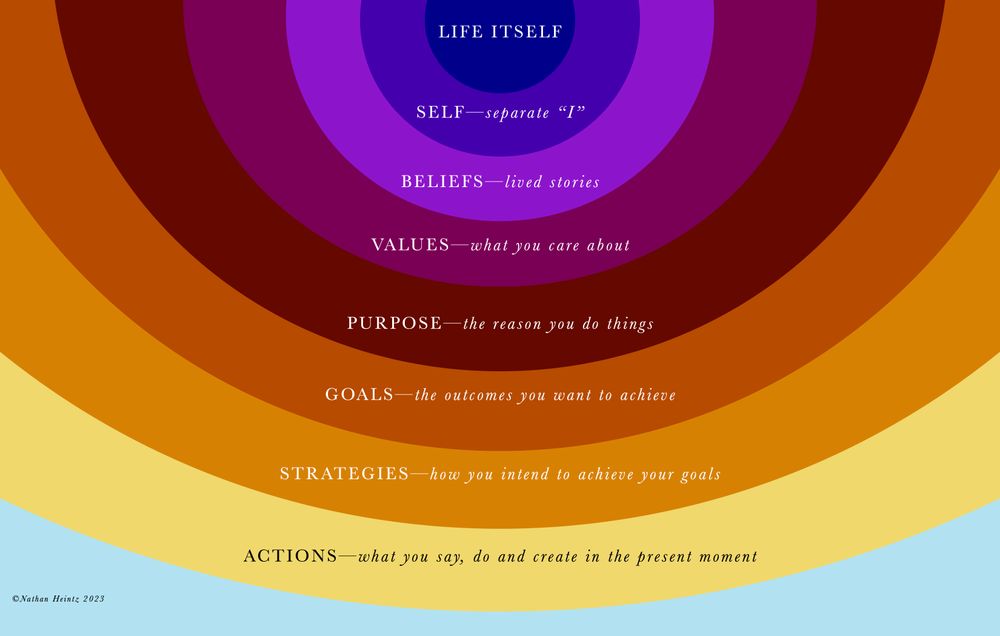In my work I've found it useful to distinguish 3 different kinds of goals: North Stars (strategic goals), Targets (outcome-based goals), and Habits (process goals). These types of goals are each necessary, each provide a different lens for we want to achieve, and each require very different approaches for getting things done.
1) North Star—Strategic Goals
Where are you going? What do you want to do or become?
What I like to call "strategic goals" are the highest level goals that we have. This is your “core mission” or your “North Star”. It’s about "where you're going", and what you want to do or become. Strategic goals set the direction of your life and your actions. These kinds of goals correspond with your interests and determine what you want to create or achieve long term.
People with a lot of different interests might struggle to narrow their focus down to one core strategic goal. “I want to become a world-class painter.” Or, “I want to travel the world doing yoga workshops”. It might be hard to do both of those things simultaneously. So without clearly prioritizing and establishing strategic goals, it’s difficult to actually make progress.
Likewise, organizations competing for funding sources or market share might be tempted to veer off course and start doing stuff that isn’t really a part of their core mission. The local theater arts organization that starts a youth science program because the money’s in STEM. Or the car company that starts making kitchen appliances instead of innovating in the domain that they’re struggling. Especially in the beginning, or in times of struggle, it’s best to have as few strategic goals as possible. Ideally just one. Because you can’t move in more than one direction at once.
2) Targets—Outcome Based Goals
What do you want to achieve? How will you know when you’ve reached your goal?
These are goals that are measurable by the end state or outcome. They’re about the results. Often long-term, these goals scope out what you want to have happen as a result of your work and activity over time. These goals are marking what you want to achieve. So I think these kinds of goals are helpful in that they can offer something to strive towards. They offer a marker in the future. They structure the larger story. These kinds of goals will often be smart goals. “I want to complete 20 paintings in the next year.” Or “I want to run 20 yoga workshops in the next 6 months.” Or, “I want to earn $30K in sales next month.”
One drawback here is that these kinds of goals might not address “how” you’re going to achieve that outcome. They’re abstracted from action, or process. You can set a very specific outcome goal and then have no idea where to even start to try to achieve it. So they deal with “what” you want to achieve but not “how” you’re going to get there.
Because they’re not about action, actually hitting these goals might not be things that are under your control. So, they might be better thought of as “targets.” For example, if your goal is to raise $100,000 to start some big project, but it turns out that no one is interested in contributing, then no matter how many people you talk to, you won’t hit your number. This doesn’t mean you failed, just that you learned something about your original target or idea.
So because the actual outcome is often out of your control, these kinds of goals need to be complimented by other kinds of thinking. You need to figure out ways to make sure that these goals are actually realistic, that you’re going in the right direction. You need to test your outcome based goals in the real world, and get feedback on them by taking real action day to day.
That’s where process goals come in.
3) Habits—Process Goals
How are you going do that? What actions are you going to take? What routines will you build?
Habitual goals—or process goals—correspond to changes you want to make in your day to day habits and practices. Your systems. It’s about the repeated actions that you take to organize and execute on your goals. This is the action part. This answers the question “how are you going to achieve those outcomes?” By building processes into your life.
So process goals are about how many hours a day or week you want to spend taking action. So for example, if you want to ship 30 pieces of writing in 30 days (outcome goal), then you probably need to be writing and editing every day. So you set the process goal of “I want to write and edit for two hours per day.” So process goals are grounded in action and can easily be built into your daily routine. If on the other hand you don’t set process goals, it’s easy to watch those outcomes pass you by without getting anything done.
The difficulty with achieving process goals is that it sometimes means shifting who you are. You may have to change your way of being, how you're showing up in the world. Sometimes habits are deeply rooted in the beliefs that we hold, and the stories that we tell ourselves about the world and ourselves. So achieving these kinds of ongoing goals means slowly cultivating and tracking new behaviors, new ways of seeing, and new ways of being. It means having some "soft skills" and building the ability to work with our inner world, our psychology, and our conditioning, over long periods of time. It means overcoming the inner barriers and getting skilled at the inner game.
These three types of goals all play interrelated roles in organizing information, motivation and work.
Strategic goals set your high-level direction and determine the type of project you're going to pursue. Outcome goals determine what practical markers or achievements you're going to shoot for to make those projects real. And process goals make sure we have the practices, systems, and ways of being in place that are going to get us there day by day.
This is an ecosystem of thinking. A clear and healthy ecosystem of goals in life and work can vastly improve our chances of actually getting things done that we want to get done.
For more insights on innovation culture and internal arts subscribe to my newsletter.








